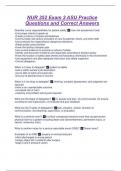NUR 352 Exam 2 ASU Practice
Questions and Correct Answers
Describe nurse responsibilities for patient safety ✅-Use risk assessment tools
-Encourage clients to speak up
-Create a culture of checks and balances
-Communicate risk factors and plans of care to patients, family, and other staff
-Use protocols for responding to dangerous situations
-Adopt quality care priorities
-Know the facility's disaster plan
-Use current evidence to promote a culture of safety
-Identify and document incidents and responses according to facility's policy
-Know the location of safety data sheets and hazardous chemicals in the environment
-Use equipment only after adequate instruction and safety inspection
-Correct delegation
When is it okay to delegate? ✅-patient is stable
-task is within worker's job description
-you're able to teach and supervise
-and you've planned how to monitor
When is it not okay to delegate? ✅-thinking, complex assessment, and judgment are
required
-there is an unpredictable outcome
-increased risk of harm
-creativity and problem solving are required
What are the steps of delegation? ✅(1) assess and plan, (2) communicate, (3) ensure
surveillance and supervision, (4) evaluate and give feedback
What are the 5 rights of delegation? ✅task, situation, worker, direction &
communication, and teaching, supervision, & evaluation
What is a sentinel event? ✅A critical unexpected adverse event that caused severe
physical harm to a patient including death and dismemberment, permanent injury, or
severe, temporary injury
What is another name for a serious reportable event (SRE)? ✅"Never event"
Examples of an SRE ✅-surgery on wrong body part
-infant discharged to wrong person
-foreign object left in patients after surgery
-stage 3 and 4 pressure ulcers
, -death associated with fall
What has to be true in order for an event to be considered an SRE? ✅to be classified
as "never event" is has to be usually preventable, unambiguous (clearly identifiable and
measurable), serious, and adverse, indicative of a problem in a healthcare facility safety
systems, and/or important for public credibility or accountability
What populations are at risk for falls? ✅Adults over 60 y/o, infants, clients receiving
opioids, clients with seizure conditions, etc.
What situations would cause the need to place a patient on a fall risk? ✅Recent fall,
recent surgery, development of disabling condition (i.e. dementia), visual impairment,
unsteady gait
Describe some nursing interventions for fall risks ✅-Hourly rounding
-frequent fall/safety risk assessments
-home hazard assessment
-ensure bed is in lowest position
-appointment of fall safety champions
-movement alarms
-physical/virtual sitter monitoring
-provide cognitive/physical activities for client
-non-skid footwear
-lock wheels of bed
-clutter free environment
-adequate lighting
-call light/belongings in reach
-fall prevention education
-restraints
Describe risk factors for any population involving fall risks (physical, cognitive,
environmental, etc.) ✅Physical disorders: stroke, amputation, recent surgery, MS,
visual impairment, chronic pain, malnutrition, weakness, unsteady gait
Cognitive: sleep disorders, impulsiveness, disorientation, depression
Environmental: room clutter, poor lighting, slippery floors
Other: certain medications with strong correlation with falls (antidepressants,
antihypertensives, opioids), staffing levels on unit, bathroom frequency
Describe physical restraints ✅appropriate only for a short term situation or procedure,
uses physical strength to restrain (ex. swaddle wrap for insertion of IV in pediatric client)




